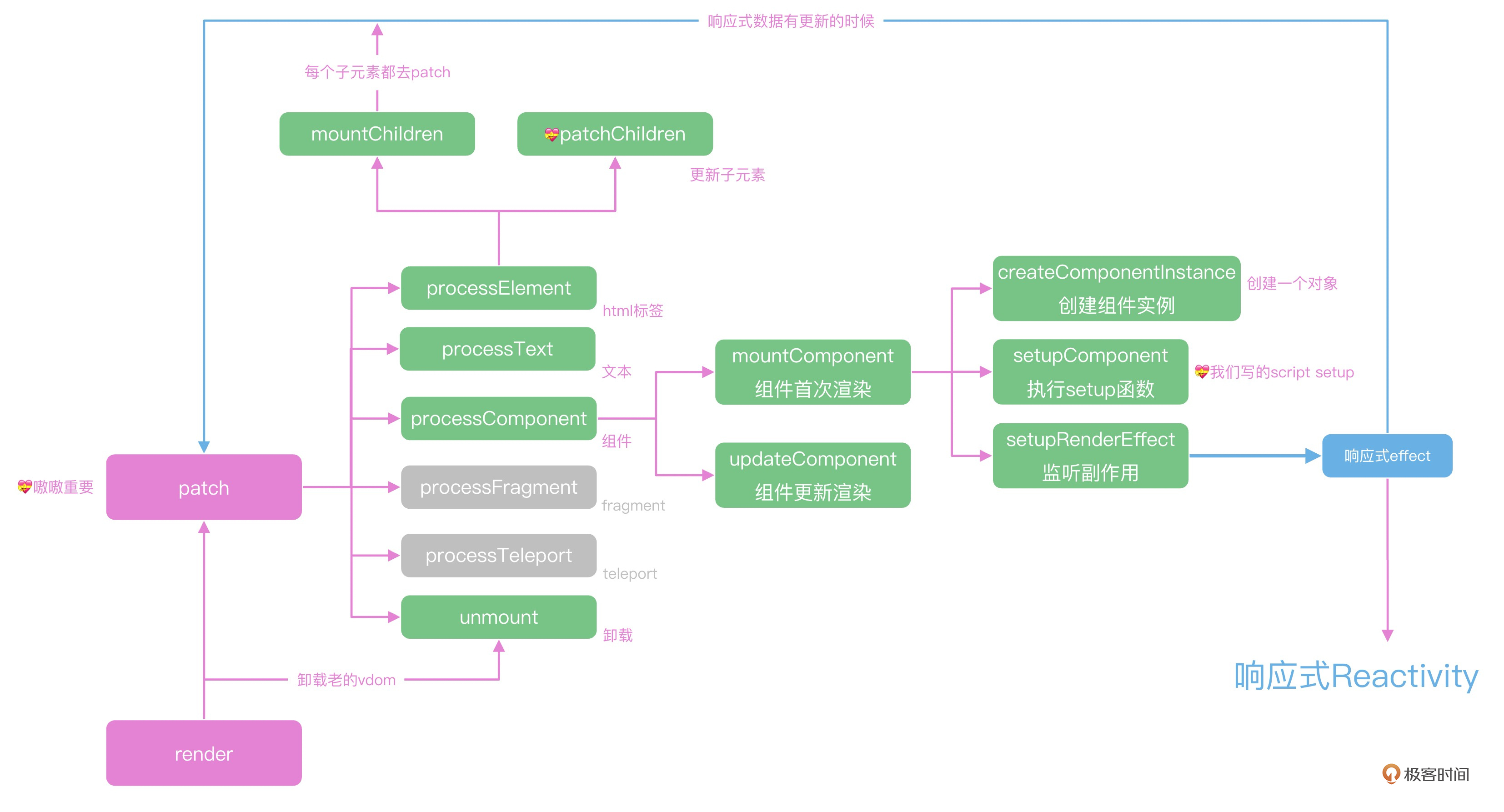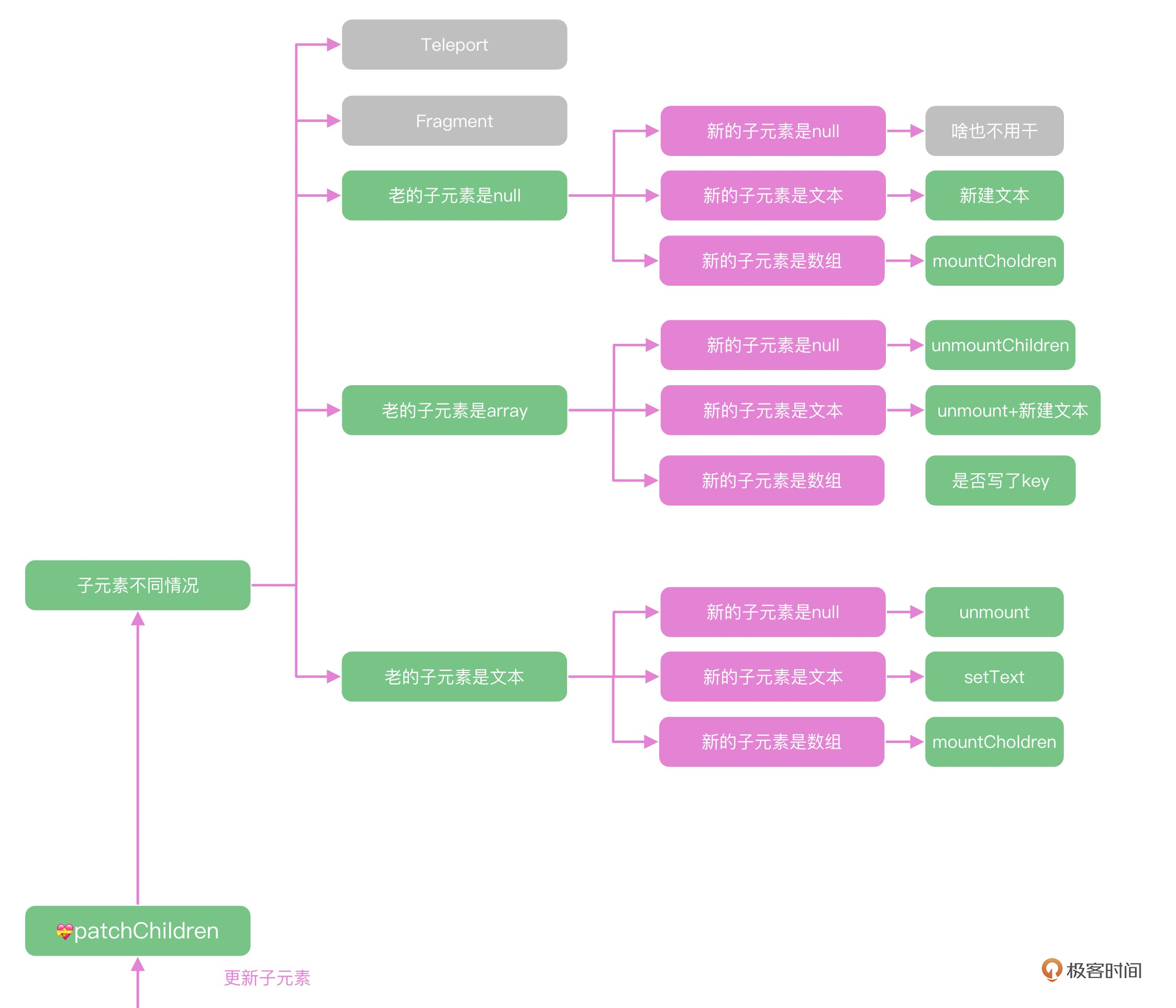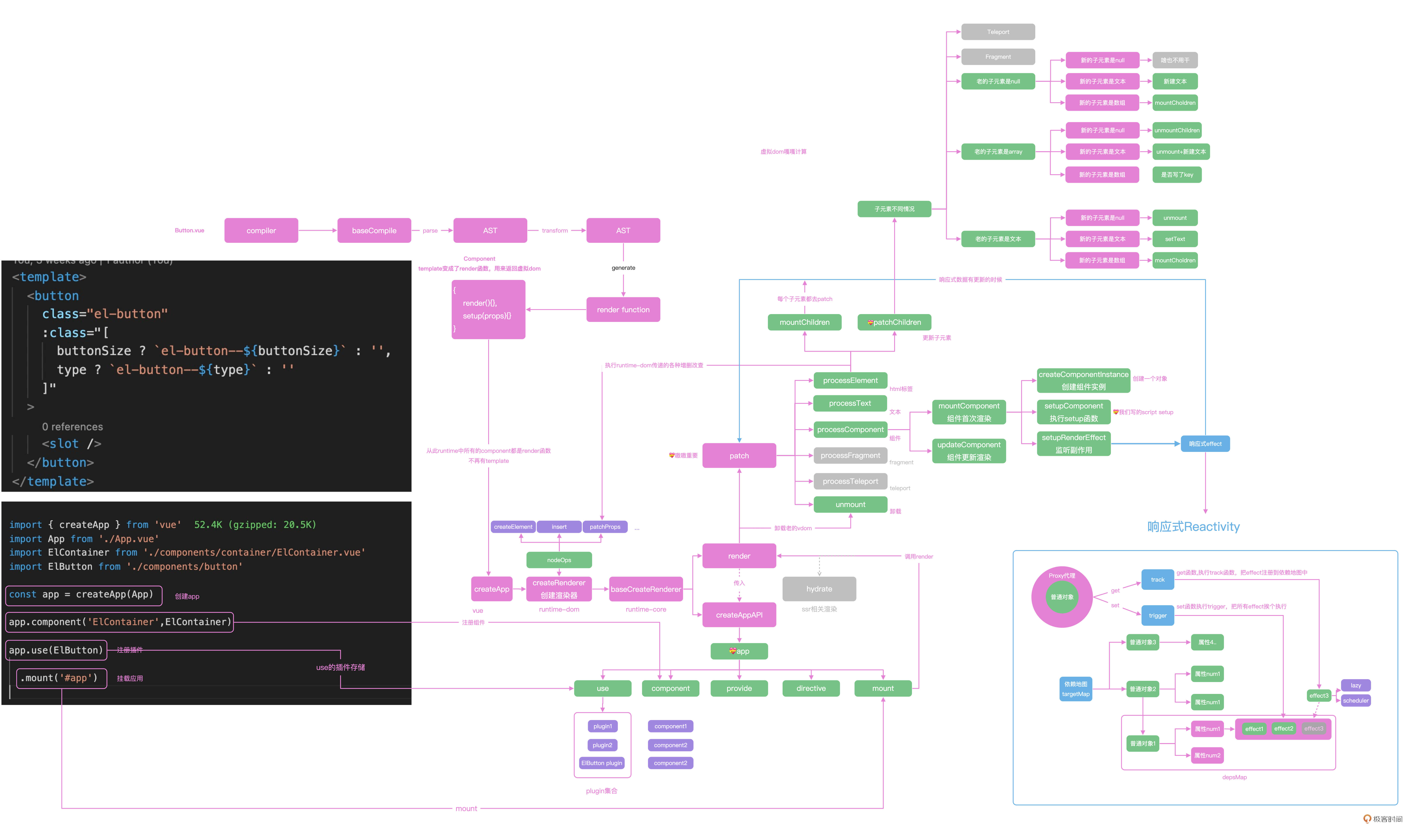|
|
# 30|虚拟DOM(上):如何通过虚拟DOM更新页面?
|
|
|
|
|
|
你好,我是大圣。
|
|
|
|
|
|
上一讲我们主要介绍了Vue项目的首次渲染流程,在mountComponent中注册了effect函数,这样,在组件数据有更新的时候,就会通知到组件的update方法进行更新。
|
|
|
|
|
|
Vue中组件更新的方式也是使用了响应式+虚拟DOM的方式,这个我们在第一讲中有介绍过Vue 1、Vue 2和Vue 3中更新方式的变化,今天我们就来详细剖析一下Vue组件内部如何通过虚拟DOM更新页面的代码细节。
|
|
|
|
|
|
## Vue虚拟DOM执行流程
|
|
|
|
|
|
我们从虚拟DOM在Vue的执行流程开始讲起。在Vue中,我们使用虚拟DOM来描述页面的组件,比如下面的template虽然格式和HTML很像,但是在Vue的内部会解析成JavaScript函数,这个函数就是用来返回虚拟DOM:
|
|
|
|
|
|
```javascript
|
|
|
<div id="app">
|
|
|
<p>hello world</p>
|
|
|
<Rate :value="4"></Rate>
|
|
|
</div>
|
|
|
|
|
|
```
|
|
|
|
|
|
上面的template会解析成下面的函数,最终返回一个JavaScript的对象能够描述这段HTML:
|
|
|
|
|
|
```javascript
|
|
|
function render(){
|
|
|
return h('div',{id:"app"},children:[
|
|
|
h('p',{},'hello world'),
|
|
|
h(Rate,{value:4}),
|
|
|
])
|
|
|
}
|
|
|
|
|
|
```
|
|
|
|
|
|
知道虚拟DOM是什么之后,那么它是怎么创建的呢?
|
|
|
|
|
|
### DOM的创建
|
|
|
|
|
|
我们简单回忆上一讲介绍的[mount函数](https://github.com/vuejs/vue-next/blob/master/packages/runtime-core/src/apiCreateApp.ts#L283),在代码中,我们使用createVNode函数创建项目的虚拟DOM,可以看到**Vue内部的虚拟DOM,也就是vnode,就是一个对象,通过type、props、children等属性描述整个节点**:
|
|
|
|
|
|
```javascript
|
|
|
const vnode = createVNode(
|
|
|
rootComponent as ConcreteComponent,
|
|
|
rootProps
|
|
|
)
|
|
|
function _createVNode() {
|
|
|
|
|
|
// 处理属性和�class
|
|
|
if (props) {
|
|
|
...
|
|
|
}
|
|
|
|
|
|
// 标记vnode信息
|
|
|
const shapeFlag = isString(type)
|
|
|
? ShapeFlags.ELEMENT
|
|
|
: __FEATURE_SUSPENSE__ && isSuspense(type)
|
|
|
? ShapeFlags.SUSPENSE
|
|
|
: isTeleport(type)
|
|
|
? ShapeFlags.TELEPORT
|
|
|
: isObject(type)
|
|
|
? ShapeFlags.STATEFUL_COMPONENT
|
|
|
: isFunction(type)
|
|
|
? ShapeFlags.FUNCTIONAL_COMPONENT
|
|
|
: 0
|
|
|
|
|
|
return createBaseVNode(
|
|
|
type,
|
|
|
props,
|
|
|
children,
|
|
|
patchFlag,
|
|
|
dynamicProps,
|
|
|
shapeFlag,
|
|
|
isBlockNode,
|
|
|
true
|
|
|
)
|
|
|
}
|
|
|
|
|
|
function createBaseVNode(type,props,children,...){
|
|
|
const vnode = {
|
|
|
type,
|
|
|
props,
|
|
|
key: props && normalizeKey(props),
|
|
|
ref: props && normalizeRef(props),
|
|
|
children,
|
|
|
shapeFlag,
|
|
|
patchFlag,
|
|
|
dynamicProps,
|
|
|
...
|
|
|
} as VNode
|
|
|
// 标准化子节点
|
|
|
if (needFullChildrenNormalization) {
|
|
|
normalizeChildren(vnode, children)
|
|
|
} else if (children) {
|
|
|
vnode.shapeFlag |= isString(children)
|
|
|
? ShapeFlags.TEXT_CHILDREN
|
|
|
: ShapeFlags.ARRAY_CHILDREN
|
|
|
}
|
|
|
return vnode
|
|
|
}componentUpdateFn
|
|
|
|
|
|
```
|
|
|
|
|
|
createVNode负责创建Vue中的虚拟DOM,而上一讲中我们讲过mount函数的核心逻辑就是使用setupComponent执行我们写的<script setup>,使用setupRenderEffect监听组件的数据变化。所以我们来到setupRenderEffect�函数中,去完整地剖析Vue中虚拟DOM的更新逻辑。
|
|
|
|
|
|
我们给组件注册了update方法,这个方法使用effect包裹后,当组件内的ref、reactive包裹的响应式数据变化的时候就会执行update方法,触发组件内部的更新机制。
|
|
|
|
|
|
看下面的代码,在setupRenderEffect内部的componentUpdateFn中,updateComponentPreRenderer更新了属性和slots,并且调用renderComponentRoot函数创建新的子树对象nextTree,然后内部依然是调用patch函数。
|
|
|
|
|
|
可以看到,**Vue源码中的实现首次渲染和更新的逻辑都写在一起,我们在递归的时候如果对一个标签实现更新和渲染,就可以用一个函数实现**。
|
|
|
|
|
|
```javascript
|
|
|
const componentUpdateFn = ()=>{
|
|
|
if (!instance.isMounted) {
|
|
|
//首次渲染
|
|
|
instance,
|
|
|
parentSuspense,
|
|
|
isSVG
|
|
|
)
|
|
|
。。。
|
|
|
}else{
|
|
|
let { next, bu, u, parent, vnode } = instance
|
|
|
if (next) {
|
|
|
next.el = vnode.el
|
|
|
updateComponentPreRender(instance, next, optimized)
|
|
|
} else {
|
|
|
next = vnode
|
|
|
}
|
|
|
const nextTree = renderComponentRoot(instance)
|
|
|
patch(
|
|
|
prevTree,
|
|
|
nextTree,
|
|
|
// parent may have changed if it's in a teleport
|
|
|
hostParentNode(prevTree.el!)!,
|
|
|
// anchor may have changed if it's in a fragment
|
|
|
getNextHostNode(prevTree),
|
|
|
instance,
|
|
|
parentSuspense,
|
|
|
isSVG
|
|
|
)
|
|
|
}
|
|
|
}
|
|
|
|
|
|
// 注册effect函数
|
|
|
const effect = new ReactiveEffect(
|
|
|
componentUpdateFn,
|
|
|
() => queueJob(instance.update),
|
|
|
instance.scope // track it in component's effect scope
|
|
|
)
|
|
|
const update = (instance.update = effect.run.bind(effect) as S chedulerJob)
|
|
|
update()
|
|
|
|
|
|
const updateComponentPreRender = (
|
|
|
instance: ComponentInternalInstance,
|
|
|
nextVNode: VNode,
|
|
|
optimized: boolean
|
|
|
) => {
|
|
|
nextVNode.component = instance
|
|
|
const prevProps = instance.vnode.props
|
|
|
instance.vnode = nextVNode
|
|
|
instance.next = null
|
|
|
updateProps(instance, nextVNode.props, prevProps, optimized)
|
|
|
updateSlots(instance, nextVNode.children, optimized)
|
|
|
|
|
|
pauseTracking()
|
|
|
// props update may have triggered pre-flush watchers.
|
|
|
// flush them before the render update.
|
|
|
flushPreFlushCbs(undefined, instance.update)
|
|
|
resetTracking()
|
|
|
}
|
|
|
|
|
|
```
|
|
|
|
|
|
比较关键的就是上面代码中32-39行的**effect函数,负责注册组件,这个函数也是Vue组件更新的入口函数。**
|
|
|
|
|
|
## patch函数
|
|
|
|
|
|
数据更新之后就会执行patch函数,下图就是patch函数执行的逻辑图:
|
|
|
|
|
|

|
|
|
|
|
|
在patch函数中,会针对不同的组件类型执行不同的函数,组件我们会执行processComponent,HTML标签我们会执行processElement:
|
|
|
|
|
|
```javascript
|
|
|
function path(n1, n2, container){
|
|
|
const { type, shapeFlag } = n2
|
|
|
switch (type) {
|
|
|
case Text:
|
|
|
processText(n1, n2, container)
|
|
|
break
|
|
|
// 还有注释,fragment之类的可以处理,这里忽略
|
|
|
default:
|
|
|
// 通过shapeFlag判断类型
|
|
|
if (shapeFlag & ShapeFlags.ELEMENT) {
|
|
|
processElement(n1, n2, container, anchor)
|
|
|
} else if (shapeFlag & ShapeFlags.STATEFUL_COMPONENT) {
|
|
|
processComponent(n1, n2, container)
|
|
|
}
|
|
|
}
|
|
|
|
|
|
}
|
|
|
|
|
|
function processComponent(n1, n2, container) {
|
|
|
// 老规矩,么有n1就是mount
|
|
|
if (!n1) {
|
|
|
// 初始化 component
|
|
|
mountComponent(n2, container)
|
|
|
} else {
|
|
|
updateComponent(n1, n2, container)
|
|
|
}
|
|
|
}
|
|
|
|
|
|
```
|
|
|
|
|
|
由于更新之后不是首次渲染了,patch函数内部会执行updateComponent,看下面的updateComponent函数内部,shouldUpdateComponent会判断组件是否需要更新,实际执行的是instance.update:
|
|
|
|
|
|
```javascript
|
|
|
const instance = (n2.component = n1.component)!
|
|
|
if (shouldUpdateComponent(n1, n2, optimized)) {
|
|
|
|
|
|
// normal update
|
|
|
instance.next = n2
|
|
|
// in case the child component is also queued, remove it to avoid
|
|
|
// double updating the same child component in the same flush.
|
|
|
invalidateJob(instance.update)
|
|
|
// instance.update is the reactive effect.
|
|
|
instance.update()
|
|
|
|
|
|
} else {
|
|
|
// no update needed. just copy over properties
|
|
|
n2.component = n1.component
|
|
|
n2.el = n1.el
|
|
|
instance.vnode = n2
|
|
|
}
|
|
|
|
|
|
```
|
|
|
|
|
|
组件的子元素是由HTML标签和组件构成,组件内部的递归处理最终也是对HTML标签的处理,所以,最后组件的更新都会进入到processElement内部的patchElement函数中。
|
|
|
|
|
|
### patchElement函数
|
|
|
|
|
|
在函数patchElement中我们主要就做两件事,更新节点自己的属性和更新子元素。
|
|
|
|
|
|
### 节点自身属性的更新
|
|
|
|
|
|
先看自身属性的更新,这里就能体现出**Vue 3中性能优化的思想,通过patchFlag可以做到按需更新**:
|
|
|
|
|
|
* 如果标记了FULL\_PROPS,就直接调用patchProps。
|
|
|
* 如果标记了CLASS,说明节点只有class属性是动态的,其他的style等属性都不需要进行判断和DOM操作。
|
|
|
|
|
|
这样就极大的优化了属性操作的性能。
|
|
|
|
|
|
内部执行hostPatchProp进行实际的DOM操作,你还记得上一讲中hostPatchProp是从nodeOps中定义的吗,其他动态属性STYLE、TEXT等等也都是一样的逻辑。Vue 3的虚拟DOM真正做到了按需更新,这也是相比于React的一个优势。
|
|
|
|
|
|
```javascript
|
|
|
const patchElement = (
|
|
|
n1: VNode,
|
|
|
n2: VNode,
|
|
|
parentComponent: ComponentInternalInstance | null,
|
|
|
parentSuspense: SuspenseBoundary | null,
|
|
|
isSVG: boolean,
|
|
|
slotScopeIds: string[] | null,
|
|
|
optimized: boolean
|
|
|
) => {
|
|
|
const el = (n2.el = n1.el!)
|
|
|
let { patchFlag, dynamicChildren, dirs } = n2
|
|
|
patchFlag |= n1.patchFlag & PatchFlags.FULL_PROPS
|
|
|
|
|
|
const oldProps = n1.props || EMPTY_OBJ
|
|
|
const newProps = n2.props || EMPTY_OBJ
|
|
|
|
|
|
// full diff
|
|
|
patchChildren(
|
|
|
n1,
|
|
|
n2,
|
|
|
el,
|
|
|
null,
|
|
|
parentComponent,
|
|
|
parentSuspense,
|
|
|
areChildrenSVG,
|
|
|
slotScopeIds,
|
|
|
false
|
|
|
)
|
|
|
|
|
|
if (patchFlag > 0) {
|
|
|
|
|
|
if (patchFlag & PatchFlags.FULL_PROPS) {
|
|
|
patchProps(
|
|
|
el,
|
|
|
n2,
|
|
|
oldProps,
|
|
|
newProps,
|
|
|
parentComponent,
|
|
|
parentSuspense,
|
|
|
isSVG
|
|
|
)
|
|
|
} else {
|
|
|
// class是动态的
|
|
|
if (patchFlag & PatchFlags.CLASS) {
|
|
|
if (oldProps.class !== newProps.class) {
|
|
|
hostPatchProp(el, 'class', null, newProps.class, isSVG)
|
|
|
}
|
|
|
}
|
|
|
|
|
|
// style样式是动态的
|
|
|
if (patchFlag & PatchFlags.STYLE) {
|
|
|
hostPatchProp(el, 'style', oldProps.style, newProps.style, isSVG)
|
|
|
}
|
|
|
|
|
|
// 属性需要diff
|
|
|
if (patchFlag & PatchFlags.PROPS) {
|
|
|
//
|
|
|
const propsToUpdate = n2.dynamicProps!
|
|
|
for (let i = 0; i < propsToUpdate.length; i++) {
|
|
|
const key = propsToUpdate[i]
|
|
|
const prev = oldProps[key]
|
|
|
const next = newProps[key]
|
|
|
// #1471 force patch value
|
|
|
if (next !== prev || key === 'value') {
|
|
|
hostPatchProp(
|
|
|
el,
|
|
|
key,
|
|
|
prev,
|
|
|
next,
|
|
|
isSVG,
|
|
|
n1.children as VNode[],
|
|
|
parentComponent,
|
|
|
parentSuspense,
|
|
|
unmountChildren
|
|
|
)
|
|
|
}
|
|
|
}
|
|
|
}
|
|
|
}
|
|
|
//文本是动态的
|
|
|
if (patchFlag & PatchFlags.TEXT) {
|
|
|
if (n1.children !== n2.children) {
|
|
|
hostSetElementText(el, n2.children as string)
|
|
|
}
|
|
|
}
|
|
|
}
|
|
|
}
|
|
|
|
|
|
```
|
|
|
|
|
|
### 子元素的更新
|
|
|
|
|
|
而子元素的更新是patchChildren 函数负责的,这个函数也是虚拟DOM中难度最高的一个函数,搞懂它还需要我们下一讲中介绍的算法知识,今天我们就先理解它主要的实现思路。
|
|
|
|
|
|
**首先我们把子元素分成了文本、数组和空三个状态,新老子元素分别是这三种状态的一个,构成了不同的执行逻辑**。这样patchChildren内部大致有五种情况需要处理:
|
|
|
|
|
|
* 如果新的子元素是空, 老的子元素不为空,直接卸载unmount即可。
|
|
|
* 如果新的子元素不为空,老的子元素是空,直接创建加载即可。
|
|
|
* 如果新的子元素是文本,老的子元素如果是数组就需要全部unmount,是文本的话就需要执行hostSetElementText。
|
|
|
* 如果新的子元素是数组,比如是使用v-for渲染出来的列表,老的子元素如果是空或者文本,直接unmout后,渲染新的数组即可。
|
|
|
|
|
|
最复杂的情况就是新的子元素和老的子元素都是数组。
|
|
|
|
|
|
最朴实无华的思路就是把老的子元素全部unmount,新的子元素全部mount,这样虽然可以实现功能,但是没法复用已经存在的DOM元素,比如我们只是在数组中间新增了一个数据,全部DOM都销毁就有点太可惜了。
|
|
|
|
|
|
**所以,我们需要判断出可以复用的DOM元素,如果一个虚拟DOM没有改动或者属性变了,不需要完全销毁重建,而是更新一下属性,最大化减少DOM的操作**,这个任务就会交给patchKeyedChildren函数去完成。
|
|
|
|
|
|
patchKeyedChildren函数,做的事情就是尽可能高效地把老的子元素更新成新的子元素,如何高效复用老的子元素中的DOM元素是patchKeyedChildren函数的难点:
|
|
|
|
|
|
```javascript
|
|
|
const patchChildren: PatchChildrenFn = (
|
|
|
n1,
|
|
|
n2,
|
|
|
container,
|
|
|
anchor,
|
|
|
parentComponent,
|
|
|
parentSuspense,
|
|
|
isSVG,
|
|
|
slotScopeIds,
|
|
|
optimized = false
|
|
|
) => {
|
|
|
const c1 = n1 && n1.children
|
|
|
const prevShapeFlag = n1 ? n1.shapeFlag : 0
|
|
|
const c2 = n2.children
|
|
|
|
|
|
const { patchFlag, shapeFlag } = n2
|
|
|
// fast path
|
|
|
if (patchFlag > 0) {
|
|
|
if (patchFlag & PatchFlags.KEYED_FRAGMENT) {
|
|
|
// this could be either fully-keyed or mixed (some keyed some not)
|
|
|
// presence of patchFlag means children are guaranteed to be arrays
|
|
|
patchKeyedChildren(
|
|
|
c1 as VNode[],
|
|
|
c2 as VNodeArrayChildren,
|
|
|
container,
|
|
|
anchor,
|
|
|
parentComponent,
|
|
|
parentSuspense,
|
|
|
isSVG,
|
|
|
slotScopeIds,
|
|
|
optimized
|
|
|
)
|
|
|
return
|
|
|
} else if (patchFlag & PatchFlags.UNKEYED_FRAGMENT) {
|
|
|
// unkeyed
|
|
|
patchUnkeyedChildren(
|
|
|
c1 as VNode[],
|
|
|
c2 as VNodeArrayChildren,
|
|
|
container,
|
|
|
anchor,
|
|
|
parentComponent,
|
|
|
parentSuspense,
|
|
|
isSVG,
|
|
|
slotScopeIds,
|
|
|
optimized
|
|
|
)
|
|
|
return
|
|
|
}
|
|
|
}
|
|
|
|
|
|
// children has 3 possibilities: text, array or no children.
|
|
|
if (shapeFlag & ShapeFlags.TEXT_CHILDREN) {
|
|
|
// text children fast path
|
|
|
if (prevShapeFlag & ShapeFlags.ARRAY_CHILDREN) {
|
|
|
unmountChildren(c1 as VNode[], parentComponent, parentSuspense)
|
|
|
}
|
|
|
if (c2 !== c1) {
|
|
|
hostSetElementText(container, c2 as string)
|
|
|
}
|
|
|
} else {
|
|
|
if (prevShapeFlag & ShapeFlags.ARRAY_CHILDREN) {
|
|
|
// prev children was array
|
|
|
if (shapeFlag & ShapeFlags.ARRAY_CHILDREN) {
|
|
|
// two arrays, cannot assume anything, do full diff
|
|
|
patchKeyedChildren(
|
|
|
c1 as VNode[],
|
|
|
c2 as VNodeArrayChildren,
|
|
|
container,
|
|
|
anchor,
|
|
|
parentComponent,
|
|
|
parentSuspense,
|
|
|
isSVG,
|
|
|
slotScopeIds,
|
|
|
optimized
|
|
|
)
|
|
|
} else {
|
|
|
// no new children, just unmount old
|
|
|
unmountChildren(c1 as VNode[], parentComponent, parentSuspense, true)
|
|
|
}
|
|
|
} else {
|
|
|
// prev children was text OR null
|
|
|
// new children is array OR null
|
|
|
if (prevShapeFlag & ShapeFlags.TEXT_CHILDREN) {
|
|
|
hostSetElementText(container, '')
|
|
|
}
|
|
|
// mount new if array
|
|
|
if (shapeFlag & ShapeFlags.ARRAY_CHILDREN) {
|
|
|
mountChildren(
|
|
|
c2 as VNodeArrayChildren,
|
|
|
container,
|
|
|
anchor,
|
|
|
parentComponent,
|
|
|
parentSuspense,
|
|
|
isSVG,
|
|
|
slotScopeIds,
|
|
|
optimized
|
|
|
)
|
|
|
}
|
|
|
}
|
|
|
}
|
|
|
}
|
|
|
|
|
|
```
|
|
|
|
|
|
上面的代码执行逻辑如下图所示,根据flags判断子元素的类型后,执行不同的操作函数:
|
|
|

|
|
|
|
|
|
### patchChildren
|
|
|
|
|
|
最后就剩下patchChildren的实现了,这也是各类虚拟DOM框架中最难实现的函数,我们需要实现**一个高效的更新算法,能够使用尽可能少的更新次数,来实现从老的子元素到新的子元素的更新**。
|
|
|
|
|
|
举个例子,类似体育课站队的时候,大家一开始站一排,但是顺序是乱的,我们需要尽快把队伍按照个头左低右高排列。
|
|
|
|
|
|
在React中,这种场景的处理逻辑是先进行循环,使用的是单侧插入的算法,我们在排队的时候挨个对比,如果你站我右边,并且个头比我高一点,说明咱俩的相对位置和最终队伍的位置是一致的,暂时不需要变化,如果你比我个头矮,就需要去我左边找到一个正确的位置插队进去。
|
|
|
|
|
|
由于都只向单侧插入,最后我们就会把所有的节点移动到正确的位置之上,这就是React15框架内虚拟节点diff的逻辑,初步实现了DOM的复用;而Vue 2借鉴了snabbdom的算法,在此基础上做了第一层双端对比的优化。
|
|
|
|
|
|
首先Web场景之下对一个数组元素的操作,很少有直接全部替换的,**比如我们操作一个表格,大概率是更关心表格某一行的一个字段、新增一行、删除一行,或者是对表格某个字段进行排序,所以我们可以从纯算法的场景之中加入实际应用的场景**。
|
|
|
|
|
|
如果我们只是在表格里新增一行,那么可以不要一开始就开始循环,而是可以先进行节点的预判。
|
|
|
|
|
|
比如,在下面的例子中,新的节点就是在老的节点中新增和删除了几个元素,我们在循环之前,先进行头部元素的判断。在这个例子里,可以预判出头部元素的a、b、c、d是一样的节点,说明节点不需要重新创建,我们只需要进行属性的更新,然后进行队尾元素的预判,可以判断出g和元素也是一样的:
|
|
|
|
|
|
```javascript
|
|
|
a b c d e f g h
|
|
|
a b c d i f j g h
|
|
|
|
|
|
```
|
|
|
|
|
|
这样我们虚拟DOM diff的逻辑就变成了下面的结构, 现在只需要比较ef和ifg的区别:
|
|
|
|
|
|
```javascript
|
|
|
(a b c d) e f (g h)
|
|
|
(a b c) d) i f j (g h)
|
|
|
|
|
|
```
|
|
|
|
|
|
相比于之前的对比场景,我们需要遍历的运算量就大大减小了。
|
|
|
|
|
|
而且,有很多场景比如新增一行或者删除一行的简单场景,预判完毕之后,新老元素有一个处于没有元素的状态,我们就可以直接执行mount或者unmout完成对比的全过程,不需要再进行复杂的遍历:
|
|
|
|
|
|
```javascript
|
|
|
(a b c d)
|
|
|
(a b c d) e
|
|
|
|
|
|
(a b c) d
|
|
|
(a b c
|
|
|
|
|
|
```
|
|
|
|
|
|
双端对比的原理大致就是这样。最后双端对比之后的执行逻辑这一部分需要一些算法知识,我们下一讲会详细介绍,这里你只需要掌握大概的思路。
|
|
|
|
|
|
想让一个队伍尽快按照个头排好序,如果能够计算出,在队伍中,个头从低到高依次递增的最多的队列,让这些人站在原地不动,其余人穿插到他们中间,就可以最大化减少人员的移动,这就是一个最长底层子序列的算法问题,我们下一讲详细剖析。
|
|
|
|
|
|
## 总结
|
|
|
|
|
|
今天的内容就讲完了,来总结一下吧,我们学习了Vue中的更新逻辑。现在Vue执行逻辑全景图变成了下面的样子,新增了组件更新的逻辑:
|
|
|
|
|
|

|
|
|
|
|
|
Vue响应式驱动了组件之间的数据通信机制,数据更新之后,组件会执行intance.update方法,update方法内部执行patch方法进行新老子树的diff计算。
|
|
|
|
|
|
在更新函数中,主要做了两件事,pathProps更新节点自身的属性,这里面使用了pathFlags做到了按需更新;patchChildren执行子元素的更新。其中patch函数内部会只对节点内部的动态属性做更新,这种按需更新的机制是Vue性能优秀的一个原因。
|
|
|
|
|
|
函数内部针对新老子元素不同的状态,执行不同的逻辑。根据子元素是否为空或者数组,以及新元素是否为空或者数组,分别执行对应的删除或者mount逻辑,其中最复杂的就是新的子元素和老的子元素都是数组。
|
|
|
|
|
|
为了最大化减少DOM操作,patchKeyedChildren使用了最长递增子序列来实现,并且相比于React的虚拟DOM diff,新增了双端的预先判断+最长递增子序列算法来实现,这也是Vue性能比较优秀的另外一个原因。
|
|
|
|
|
|
## 思考题
|
|
|
|
|
|
最后再留一个思考题,从虚拟DOM更新的角度,为什么我们在写v-for循环的时候,都要建议使用key属性呢?欢迎在评论区留下你的答案,也欢迎你把这一讲分享给你的同事和朋友们,我们下一讲再见。
|
|
|
|